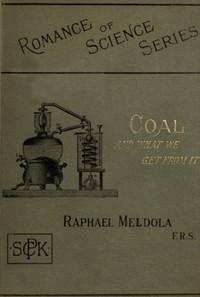Read this ebook for free! No credit card needed, absolutely nothing to pay.
Words: 34854 in 15 pages
This is an ebook sharing website. You can read the uploaded ebooks for free here. No credit cards needed, nothing to pay. If you want to own a digital copy of the ebook, or want to read offline with your favorite ebook-reader, then you can choose to buy and download the ebook.
country by wooden poles, of which the ends are buried in the earth. Consider also the many subaqueous works which necessitate the use of timber, and we shall gain an idea of the demand for heavy coal-tar oil created by the introduction of Br?ant's process. Under the treatment described a cubic foot of wood absorbs about a gallon of oil, and by far the largest quantity of the tar oils is consumed in this way at the present time. Now in the early days of timber-pickling the lighter oils of the tar, which first come over on distillation, and which are too volatile for the purpose of creosoting, were in much about the same industrial position as the tar itself before its application as a timber preservative. The light oil had a limited use as a solvent for waterproofing and varnish making, and a certain quantity was burnt as coal-tar naphtha in specially constructed lamps, the invention of the late Read Holliday of Huddersfield, whose first patent was taken out in 1848 . Up to this time, be it remembered, that chemists had not found out what this naphtha contained. But science soon laid hands on the materials furnished by the tar-distiller, and the naphtha was one of the first products which was made to reveal the secret of its hidden treasures to the scientific investigator. From this period science and industry became indissolubly united, and the researches of chemists were carried on hand-in-hand with the technical developments of coal-tar products.
In 1825 Michael Faraday discovered a hydrocarbon in the oil produced by the condensation of "oil gas"--an illuminating gas obtained by the destructive distillation of oleaginous materials. This hydrocarbon was analysed by its illustrious discoverer, and named in accordance with his results "bicarburet of hydrogen." In 1834 the same hydrocarbon was obtained by Mitscherlich by heating benzoic acid with lime, and by P?ligot by the dry distillation of calcium benzoate. For this reason the compound was named "benzin" by Mitscherlich, which name was changed into "benzol" by Liebig. In this country the hydrocarbon is known at the present time as benzene. Twenty years after Faraday's discovery, viz. in 1845, Hofmann proved the existence of benzene in the light oils from coal-tar, and in 1848 Hofmann's pupil, Mansfield, isolated considerable quantities of this hydrocarbon from the said light oils by fractional distillation. At the time of these investigations no great demand for benzene existed, but the work of Hofmann and Mansfield prepared the way for its manufacture on a large scale, when, a few years later, the first coal-tar colouring-matter was discovered by our countryman, W. H. Perkin.
The year 1856 marks an epoch in the history of the utilization of coal-tar products with which the name of Perkin will ever be associated. In the course of some experiments, having for their object the artificial production of quinine, this investigator was led to try the action of oxidizing agents upon a base known as aniline, and he thus obtained a violet colouring matter--the first dye from coal-tar--which was manufactured under a patent granted in 1858, and introduced into commerce under the name of mauve. A brief sketch of the history of aniline will serve to show how Perkin's discovery gave a new value to the light oils from coal-tar and raised the manufacture of nitrobenzene into an important branch of industry.
Thirty years before Perkin's experiments the Dutch chemist Unverdorben obtained a liquid base by the distillation of indigo, which had the property of forming beautifully crystalline salts, and which he named for this reason "crystallin." In 1834 Runge discovered the same base in coal-tar, although its identity was not known to him at the time, and because it gave a bluish colour when acted upon by bleaching-powder, he called it "kyanol." Again in 1840, by distilling a product obtained by the action of caustic alkalies upon indigo, Fritzsche prepared the same base, and gave it the name of aniline, from the Spanish designation of the indigo plant, "anil," derived from the native Indian word, by which name the base is known at the present time. That aniline could be obtained by the reduction of nitrobenzene was shown by Zinin in 1842, who used sulphide of ammonium for reducing the nitrobenzene, and named the resulting base "benzidam." The following year Hofmann showed that crystallin, kyanol, aniline, and benzidam were all one and the same base. Thus when the discovery of mauve opened up a demand for aniline on the large scale, the labours of chemists, from Unverdorben in 1826 to Hofmann in 1843, had prepared the way for the manufacturer. It must be understood that although Runge had discovered aniline in coal-tar, this is not the source of our present supply, for the quantity is too small to make it worth extracting. A mere trace of aniline is present in the tar ready formed; from the time this base was wanted in large quantities it had to be made by nitrating benzene, and then reducing the nitrobenzene.
The light oils of tar distillation rejected by the timber-pickling industry now came to the front, imbued with new interest to the technologist as a source of benzene for the manufacture of aniline. The inauguration of this manufacture, like the introduction of steam locomotion, is connected with a sad catastrophe. Mansfield, who first showed manufacturers how to separate benzene and other hydrocarbons from the light oils of coal-tar, and who devised for this purpose apparatus similar in principle to that used on a large scale at the present time , met with an accident which resulted in his death. In the upper part of a house in Holborn in February 1856, this pioneer was carrying on his experiments, when the contents of a still boiled over and caught fire. In his endeavours to extinguish the flames he received the injuries which terminated fatally. Applied science no less than pure science has had its martyrs, and among these Mansfield must be ranked.
The operation of tar-distilling is about as unromantic a process as can be imagined, but it must be briefly described before the subsequent developments of the industry can be appreciated properly. It has already been explained that the tar is a complex mixture of many different substances. These various compounds boil at certain definite temperatures, the boiling-point of a chemical compound being an inherent property. If a mixture of substances boiling at different temperatures is heated in a suitable vessel the compounds distil over, broadly speaking, in the order of their boiling-points. The separation by this process is not absolute, because compounds boiling at a certain temperature have a tendency to bring over with them the vapours of other compounds which boil at a higher temperature. But for practical purposes it will be sufficient to consider that the general tendency is for the compounds of low boiling-point to come over first, then the compounds of higher boiling-point, and finally those of the highest boiling-point. This is the principle made use of by the tar-distiller. The tar-still is a large iron pot provided with a still-head from which the vapours boil out into a coil of iron pipe kept cool in a vessel of water . The still is heated by a fire beneath it, and the different portions which condense in the iron coil are received in vessels which are changed as the different fractions of the tar come over. The process is what chemists would call a rough fractional distillation. The first fractions are liquid at ordinary temperatures, and the water in the condenser is kept cold; then, as the boiling-point rises, the fraction contains a hydrocarbon which solidifies on cooling, and the water in the condenser is made hot to prevent the choking up of the coil. Every one of these fractions of coal-tar, from the beginning to the end of the process, has its story to tell--all the chief constituents of the tar separated by this means have by chemical science been converted into useful products.
It has already been said that coal-tar is a complex mixture of various distinct chemical compounds. Included among the gases, ammoniacal liquor, and tar, the compounds which are known to be formed by the destructive distillation of coal already reach to nearly one hundred and fifty in number. Of the substances present in the tar, about a dozen are utilized as raw materials by the manufacturer, and these are contained in the fractions described above. The first runnings and light oil contain a series of important hydrocarbons, of which the three first members are known to chemists as benzene, toluene, and xylene, the latter being present in three different modifications. The carbolic oil furnishes carbolic acid and naphthalene, and the anthracene oil the hydrocarbon which gives its name to that fraction. Here we have only half a dozen distinct chemical compounds to deal with, and if we confine our attention to these for the present, we shall be enabled to gain a good general idea of what chemistry has done with these raw materials. The products separated during the processes which have to be resorted to for the isolation of these raw materials have also their uses, which will be pointed out incidentally.
Beginning with the first runnings and the light oil, from which the hydrocarbons of the benzene series are separated, we have to make ourselves acquainted with the treatment to which these fractions are submitted by the tar-distiller. The light oil is first distilled from an iron still, similar to a tar-still, and the first portions which come over are added to the oily fraction brought over by the water of the first runnings. The separation of the oil from the water in this last fraction is a simple matter, because the hydrocarbons float as a distinct layer on the water, and do not mix with it. We have at this stage, therefore, four products to consider, viz. 1st, the oil from the first runnings; 2nd, the first portions of the light oil; 3rd, the later portions of the light oil; and 4th, the residue in the still. The first and second are mixed together, and the third is washed alternately with alkali and acid to remove acid and basic impurities, and can then be mixed with the first and second products. The total product is then ready for the next operation. The last portion of the light oil which remains in the still is useless as a source of benzene hydrocarbons, and goes into the heavy oil of the later tar fractions.
The total product containing the benzene hydrocarbons is put through such a series of washing operations as above described, and is then ready for separation into its constituents by another and more perfect process of fractional distillation. This final separation is effected in a piece of apparatus somewhat complicated in structure, but simple in principle. It is a development on a large scale of the apparatus used by Mansfield in his early experiments. The details of construction are not essential to the present treatment of the subject, but it will suffice to say that the vapours of the boiling hydrocarbons ascend through upright columns, in which the compounds of high boiling-point first condense and run back into the still, while the lower boiling-point compounds do not condense in the columns, but pass on into a separate condenser, where they liquefy and are collected. But even with this rectification we do not get a perfect separation--the hydrocarbons are not perfectly pure from a chemical point of view, although they are pure enough for manufacturing purposes. Thus the first fraction consists of benzene containing a small percentage of toluene, then comes over a mixture containing a larger proportion of toluene, then comes a purer toluene mixed with a small percentage of xylene. The boiling-points of the three hydrocarbons are 81? C., 111? C., and 140? C. respectively; but owing to the nature of fractional distillation, a compound of a certain boiling-point always brings over with it a certain quantity of the compound of higher boiling-point, and that is why the rectifying column effects only a partial separation.
Of the hydrocarbons thus separated, benzene and toluene are by far the most important; there is but a limited use for the xylenes at present, and these and the hydrocarbons of higher boiling-point belonging to the same series which distil over between 140? and 150? constitute what is known as "solvent naphtha," because it is used for dissolving india-rubber for waterproofing purposes. The hydrocarbons of still higher boiling-point which remain in the still are used as burning naphtha for lamps. If benzene of a higher degree of purity is required--as it is for the manufacture of certain colouring-matters--the fraction containing this hydrocarbon can be again distilled through the rectifying column, and a large proportion of the toluene thus separated from it. Finally, pure benzene can be obtained by submitting the rectified hydrocarbon to a process of refrigeration in a mixture of ice and salt, when the benzene solidifies to a white crystalline solid, while the toluene does not solidify, and can be drained away from the benzene crystals which liquefy at about 5? C.
The account rendered by the technologist with respect to the light oils of the tar is thus a pretty good one. Already we see that benzene, toluene, solvent naphtha, and burning naphtha are separated from them. Even the alkaline and acid washings may be made to surrender their contained products, for the first of these contains a certain quantity of carbolic acid, and the acid contains a strongly smelling base called pyridine, for which there is at present no great demand, but which may one day become of importance. The actual quantity of benzene in tar is a little over one per cent. by weight, and of toluene there is somewhat less. The naphthas are present to the extent of about 35 per cent.
Nitrotoluene and toluidine each exist in three distinct modifications, so that it is more correct to speak of the nitrotoluenes and the toluidines; but the explanation of these differences belongs to pure chemical theory, and cannot now be attempted in detail. It must suffice to say that many compounds having the same chemical composition differ in their properties, and are said to be "isomeric," the isomerism being regarded as the result of the different order of arrangement of the atoms within the molecule.
Free books android app tbrJar TBR JAR Read Free books online gutenberg
More posts by @FreeBooks

: Joseph in the Snow and The Clockmaker. In Three Volumes. Vol. III. by Auerbach Berthold Wallace Grace Lady Translator - German fiction Translations into English


: Joseph in the Snow and The Clockmaker. In Three Volumes. Vol. II. by Auerbach Berthold Wallace Grace Lady Translator - German fiction Translations into English








